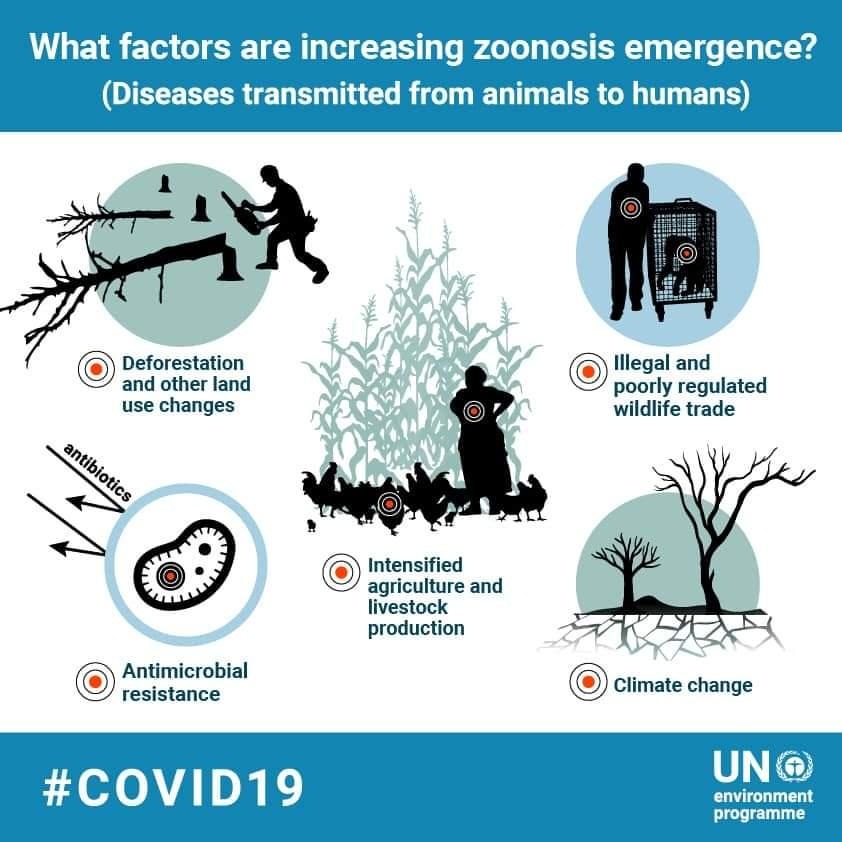Biodiversity & Environment
Human Activities Responsible for Zoonoses
- 22 Apr 2020
- 5 min read
Why in News
According to the UN Environment Programme (UNEP), 60% of human infectious diseases originate from animals.
Key Points
- Zoonoses
- It is the name given to diseases transmitted from animals to humans.
- It is based on the Greek words for “animal” and “sickness”.
- Examples: Rabies (rabid dogs), Ebola (fruit bats), West Nile virus (infected mosquitoes), the Zika virus (infected Aedes species mosquito)–and the most recent - the novel coronavirus Covid-19 (bat/pangolin).
- Data Related to Zoonoses
- On an average, one new infectious disease emerges in humans every four months.
- A study by American researchers that was completed before the new coronavirus outbreak identifies rodents, primates and bats as hosts of three-quarters of viruses transmitted to humans.
- Domestic animals also carry about 50% of the zoonoses identified.
- In 2016, the UNEP pointed out that 75% of all emerging infectious diseases (such as Ebola, HIV, avian flu, Zika, or SARS) in humans are zoonotic (pertaining to zoonoses).
- According to it, these zoonotic diseases are closely interlinked with the health of ecosystems.
- Deaths due to Zoonoses: Beyond the current outbreak of coronavirus, the Intergovernmental Science-Policy Platform on Biodiversity and Ecosystem Services (IPBES) estimates that zoonoses kill some 700,000 people a year.
- On an average, one new infectious disease emerges in humans every four months.
- Changed Ecosystems
- Zoonoses are opportunistic and thrive where there are changes in the environment, changes in animal or human populations that serve as hosts for certain pathogens, or changes in the pathogen (disease causing microorganisms), itself.
- In the last century, a combination of population growth and reduction in ecosystems and biodiversity has culminated in unprecedented opportunities for pathogens to pass between animals and people.
- Humans-led Changes in the Environment
- By altering land use–for settlement, agriculture, logging, extractive or other industries and their associated infrastructure–humans fragment and encroach into animal habitats.
- Destruction of natural buffer zones that would normally separate humans from animals, thus creating opportunities for pathogens to spill over from wild animals to people.
- Climate change– primarily the result of greenhouse gas emissions–exacerbates the situation. Changes in temperature, humidity and seasonality directly affect the survival of microbes in the environment.
- Proximity to different species through wet markets (live animal market) or consumption of wild animals can also facilitate animal to human transmission.
- Resistance to Drugs: One example of this is the emerging resistance of pathogens to antimicrobial drugs–such as antibiotics, antifungals, antiretrovirals and antimalarials–often resulting from the misuse of the drugs, either by people or in veterinary medicine.
- Domesticated animals are often a “bridge” between pathogens from the wild and humans.
- Global Action
- UNEP, the UN Food and Agriculture Organization, and hundreds of partners across the planet have launched a 10-year effort to prevent, halt and reverse the degradation of ecosystems worldwide.
- Known as the UN Decade on Ecosystem Restoration 2021-2030, this globally-coordinated response to the loss and degradation of habitats will focus on building political will and capacity to restore humankind’s relation with nature.
- Suggestions
- Addressing zoonotic disease emergence requires addressing its root cause–primarily, the impact of human activities on ecosystems.
- Ecosystems are inherently resilient and adaptable and, by supporting diverse species, they help to regulate diseases. The more biodiverse an ecosystem is, the more difficult it is for one pathogen to spread rapidly or dominate.
- There is a need to recognise the close relationships between human, animal and environmental health. It calls for collaborative, multisectoral, transdisciplinary and international efforts, as encapsulated by the One Health approach. At last, a strong will is necessary.
- Addressing zoonotic disease emergence requires addressing its root cause–primarily, the impact of human activities on ecosystems.
Intergovernmental Science-Policy Platform on Biodiversity and Ecosystem Services
- IPBES is an independent intergovernmental body established to strengthen the science-policy interface for biodiversity and ecosystem services for the conservation and sustainable use of biodiversity, long-term human well-being and sustainable development.
- It was established in Panama City (US), in April 2012.
- It is not a United Nations body.







